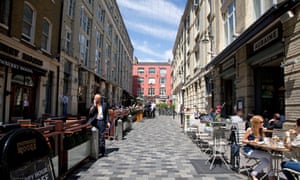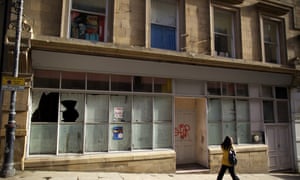
Buyers in England and Wales forced to spend up to 12 times their income as gap between earnings and house prices widens
The gap between income and house prices has sky-rocketed so much in the last 20 years that even in the most affordable regions of England and Wales buyers are forced to spend six times their income, a new data analysis reveals.
The situation is most dire in the capital, where the median house now costs 12 times the median London income.
The Guardian analysed 19 million sales over 20 years from Land Registry and HMRC data. It shows how in every region in England and Wales there have been dramatic increases in house prices in proportion to incomes, fuelling concerns that millions will be locked out of the UK property market.
A homebuyer earning the median salary for their region in 1995 would have had to spend between 3.2 times and 4.4 times their salary on a house, depending on where they lived. In 2012-13, the last year for which complete data is available, the median house price had risen to between 6.1 times and 12.2 times median regional incomes.
In 1995, the median income in London was £19,000 and the median house price was £83,000, meaning that people were spending 4.4 times their income on buying a property. But by 2012-13, the median income in London had increased to £24,600 and the median house price in the capital had increased to £300,000, meaning people were forced to spend 12.2 times their income on a house.
Even in more affordable regions, prices have risen dramatically. In the north-east, the most affordable region in England and Wales, the proportion of income spent on property has almost doubled in 20 years, increasing from 3.4 times the median income of the region in 1995 to 6.1 times the median income in 2012.
“The biggest factor is that in the run-up to the crash, interest rates were low, so you could afford to service a bigger mortgage then. There was also low inflation on essentials like food, fuel, transport and utilities, so people had more money in their pockets and were able to gear up for bigger mortgages.”
Duncan Stott, director of affordable housing campaign group PricedOut, said these figures indicated that the gap between the “housing haves and the housing have-nots” was getting ever wider.
“It’s not just that every region has got more expensive, but how much more expensive some regions have got. When you look at places where housing prices are increasing, places like Cambridge, Reading, Bristol, Oxford, these are places where jobs are being created but they’re completely unaffordable, so there’s a huge mismatch between the labour market and the housing market.”
After London, the most expensive regions for property are the south-east and south-west of the country, where houses cost 9.9 and 9.2 times the median incomes of those regions respectively. This is followed by the east of England (8.8 times median income), the West Midlands (7.3 times), the east Midlands (6.9 times), Wales (6.8 times), and Yorkshire and the north-west (each 6.6 times).

The most expensive postcode district to buy property in 2014 was Mayfair in London. Twenty-six properties were sold in that postcode district in 2014; the median house price was £2.9m, the most expensive property sold in the area to an individual cost £18.4m and the cheapest went for £155,100.
London accounted for the 36 most expensive postcode districts in the country, with Leatherhead in Surrey the 37th. In Leatherhead, the median house price in 2014 was £775,000 and the most expensive property sold that year went for £2.9m.
The postcode district where houses were cheapest was central Bradford in West Yorkshire where there were 191 sales in 2014. The median house price in BD1 was £40,000, with the cheapest property selling for £29,000. After Bradford, the most affordable districts were Ferndale in the Rhondda Valley, followed by Grimsby in Lincolnshire, New Tredegar in Caerphilly, and Middlesbrough.
The most expensive house sold to an individual in 2014 was in London and went for £50m, while the cheapest was a £7,000 property in north-east England.
The gap between house prices and income have led the OECD to class the UK in the category of countries “where houses appear overvalued but prices are rising”. The OECD warns that economies in this category, which also include Canada, Australia and New Zealand, are vulnerable to the risk of price corrections.
Stott warned that rising house prices meant more people would be perpetual renters, which would have untold effects on society. “It takes a toll on young people who can’t afford a house. A lot of us are going to be spending our lives renting and we need to be thinking about the implications for children growing up in private rentals and how on earth we pay the rent when we retire, which no one is talking about.
“It’s an unsustainable setup we’ve got, if we don’t deal with problems now – the lack of supply, lack of mortgage controls and lack of property tax reform – we’re going to sleepwalk into these problems,” he said.

